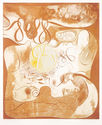
19th, 20th & 21st Century Fine Prints
707-546-7352 · fax 707-546-7924 · web: www.annexgalleries.com · email: artannex@aol.com
Arthur Thrall Biography
Arthur Thrall
American
1926–2015
Biography
Music, calligraphy, typography, and texture: these are the hallmarks of Arthur Thrall’s printmaking and painting. Born in Milwaukee, Wisconsin on March 18, 1926, Thrall was the second of nine children born to Irving and Helen Thrall. Upon graduation from Washington High School, Thrall enlisted for duty in the U.S. Armed Forced and served from 1944 to 1946. This allowed him to pursue an education on the G.I. Bill, and he began his studies at the Milwaukee State Teachers College (now the University of Wisconsin-Milwaukee) for undergraduate studies, followed by graduate degree work at the University of Illinois-Urbana. Among his teachers he counted Robert von Neumann, Joseph Friebert, and Alfred Sessler as among the most influential, inspired by the Social Realism they brought to the curriculum. Modernism had not yet made headway in much of the Mid West and the populace was still recovering from the Great Depression and World War II, and for Thrall it was his teachers' frank and empathetic imagery that held the most power for him.
The printmaking department at the UW-Madison had established itself as one of the country’s foremost hubs for experimental techniques by the mid 1950s, attracting students from all over the country. Thrall, now teaching at the Milwaukee-Downer College on the recommendation of fellow artist Carl F. Riter, continued his pursuit of both intaglio and block printmaking and was awarded a fellowship to a summer workshop at Ohio State University. There he studied under Sidney Chafetz and guest teacher Stanley William Hayter, founder of Atelier 17 in Paris and New York. His prints from the early 1960s reflect that time of experimental intaglio, with vibrant, contrasting weights in line and texture. While at the workshop, Thrall met fellow printmaking student Winifred “Win” Rogers, with whom he assisted Hayter in preparing plates for demonstration. They would later marry.
As Thrall pursued art, he discovered a love of typography, graffiti, and the layers of architectural decay exposed in the process of rebuilding, as Milwaukee underwent the kind of urban development that had gained speed across the country after the end of World War II. Thrall’s fascination with these subjects led to a grant in graphics studies from the Louis Comfort Tiffany foundation. He was then able to travel to the Morgan Library in New York and Library of Congress in Washington, D.C., studying the aesthetics of manuscripts from throughout history. By the mid-1960s the loops of Western cursive and the elegant lines of Middle Eastern characters were a prominent fixture of his work.
Thrall took a sabbatical in London in 1973, bringing his family to live there. Through contacts at the Slade School of Art, Morley College, and the Charlotte Street Print Workshop, Thrall was able to make several significant connections. One such meeting was with Jack Thompson, an independent music engraver contracted by what was then the world’s largest publisher of classical music, Boosley and Hawkes. Thrall was an avid admirer of classical music and composition, the two became fast friends. Thompson exchanged a small collection of old German music-note punch tools for a Thrall print with a musical theme. Soon, the music notes became an integral part of Thrall’s work, appearing in many of his prints until the end of his career.
In 1974 he took a position at the London campus of Wisconsin’s Lawrence University, for a year, and upon his return became the Ferrar-Marrs Fine Arts Chair, teaching art until his retirement in 1990. He continued to work in his studio at his Milwaukee Nut Factory studio on Fratney Street until just weeks before his death on March 11, 2015.







